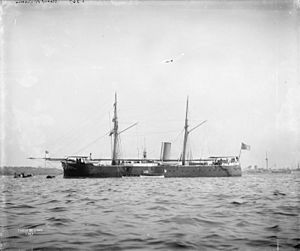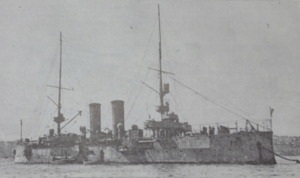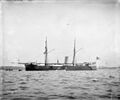Portuguese ironclad Vasco da Gama facts for kids

Vasco da Gama at the opening of the Kaiser Wilhelm Canal in 1895
|
|
Quick facts for kids History |
|
|---|---|
| Name | Vasco da Gama |
| Namesake | Vasco da Gama |
| Builder | Thames Iron Works, Blackwall, London |
| Laid down | 1875 |
| Launched | 1 December 1876 |
| Completed | 1878 |
| Fate | Broken up in 1935 |
| General characteristics | |
| Displacement | 2,384 t (2,346 long tons; 2,628 short tons) |
| Length | 200 ft (61 m) pp |
| Beam | 40 ft (12 m) |
| Draft | 19 ft (5.8 m) |
| Installed power | 3,000 ihp (2,200 kW) |
| Sail plan | Barquentine rig |
| Speed | 10.3 knots (19.1 km/h; 11.9 mph) |
| Complement | 232 men |
| Armament |
|
| Armor |
|
Vasco da Gama was a powerful warship called an ironclad. She was built for the Portuguese Navy in the 1870s in London. Her main job was to protect Lisbon, the capital city of Portugal.
The ship was launched in 1876 and finished in 1878. For most of her long life, Vasco da Gama was the most important ship in the Portuguese fleet, known as the flagship. She was given a big upgrade between 1901 and 1903. Her crew was involved in some protests in 1913 and 1914. During the 1914 event, they fired cannons towards Lisbon. By the 1930s, the ship was very old and not useful anymore. Vasco da Gama was finally taken apart for scrap metal in 1935.
Contents
Building a Warship: Vasco da Gama
Vasco da Gama was the only large warship, known as a capital ship, ever built for the Portuguese Navy. Portugal ordered her from a British shipyard. The goal was to protect their capital city, Lisbon, from attacks by sea.
Ship's Size and Power
Vasco da Gama was about 200 feet (61 m) long. She was 40 ft (12 m) wide, but at the main guns, she was even wider, about 46 ft 6 in (14.17 m). The ship sat 19 ft (5.8 m) deep in the water.
When first built, she weighed about 2,384 metric tons (2,346 long tons; 2,628 short tons). The ship moved using a marine steam engine that turned a single screw propeller. Steam for the engine came from boilers, with smoke leaving through one funnel. Her engine could produce 3,000 indicated horsepower (2,200 kW), giving her a top speed of 10.3 knots (19.1 km/h; 11.9 mph). She also had two masts with a barquentine rig to help her sail when needed. The ship had a crew of 232 sailors and officers.
Weapons and Protection
When first built, Vasco da Gama had two large 10.2 in (260 mm) guns. These guns were placed in a strong, armored box in the middle of the ship. This box had several openings, allowing the guns to fire forwards, backwards, and to the sides.
She also had one 5.9 in (150 mm) gun at the back of the ship. For close-up defense against small, fast torpedo boats, she carried four smaller 9-pounder guns.
The ship was protected by a thick iron armored belt. This belt was 4 inches (100 mm) thick at the ends and 9 in (230 mm) thick in the middle. The thickest part protected important areas like the ammunition storage and engine rooms. The armored box around the main guns was protected by armor between 6 to 10 inches (150 to 250 mm) thick.
Major Ship Upgrades
In 1901, the ship went through a huge rebuild. She was cut in half and made longer by 32 ft 6 in (9.91 m). She received new, more powerful engines and boilers. This made her much faster, reaching 15.5 kn (28.7 km/h; 17.8 mph). Her sailing masts were removed since the engines were now strong enough.
Her old main guns were replaced with new 8 in (203 mm) L/40 guns. The smaller 5.9-inch gun was also replaced with a newer, longer one. Six smaller 3-pounder guns were added for close defense. The old iron armor was taken off and stronger steel armor was put in its place. After all these changes, the ship's crew grew to 260 people. Her weight also increased to 2,972 metric tons (2,925 long tons; 3,276 short tons).
Vasco da Gama's Long Career
Vasco da Gama was built at the Thames Iron Works shipyard in London, Britain, starting in 1875. She was launched into the water on December 1, 1876, and finished in 1878.
She served as part of the defense force for Lisbon, the Portuguese capital, and the Tagus river mouth. On June 26, 1897, Vasco da Gama took part in a large naval parade, called a Fleet Review, at Spithead. This event celebrated Queen Victoria's 60 years as queen. At that time, Captain Augusto Barreto de Vascomellos was her commander.
In 1901, Vasco da Gama went to a shipyard in Livorno, Italy, for her big reconstruction. This work was finished by 1903. Later, on August 27, 1907, a gas explosion happened on board, injuring some crew members.
Political Role and Final Years
Vasco da Gama remained the most important ship in the Portuguese Navy even into the 1910s. This was because Portugal did not have enough money to build a new, modern replacement. During this time, the Portuguese Navy became very involved in the country's politics.
In April 1913, during a time of political trouble, some of Vasco da Gama's crew had to be removed. They were involved in a plan to overthrow the government. On May 14, 1915, the crew again took part in unrest. They rebelled, and fired the ship's cannons towards Lisbon.
In December 1917, the Portuguese Army tried to take control of the government. The navy fought back on January 8, 1918, to try and bring back the old government. Vasco da Gama, still the fleet's flagship, and two destroyers, Douro and Guadiana, were anchored in Lisbon. Army cannons fired at the ships. Vasco da Gama fired back for about 25 minutes. However, the ships eventually gave up and raised a white flag. None of the ships were damaged in this event.
By 1935, Vasco da Gama was very old and no longer useful for fighting. She was sold and taken apart for scrap metal that year.
Images for kids



